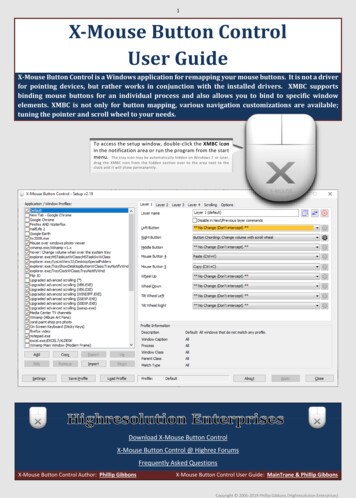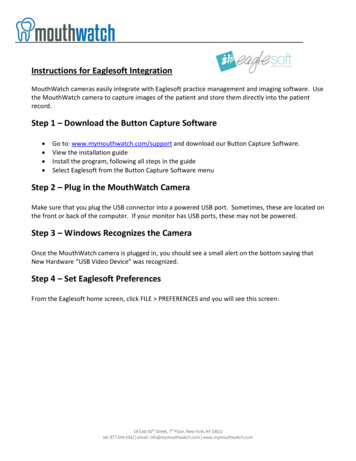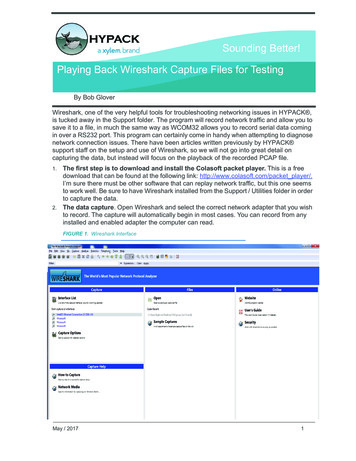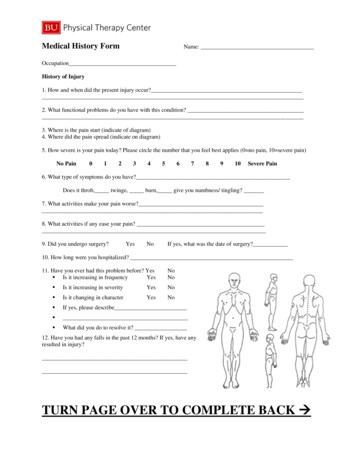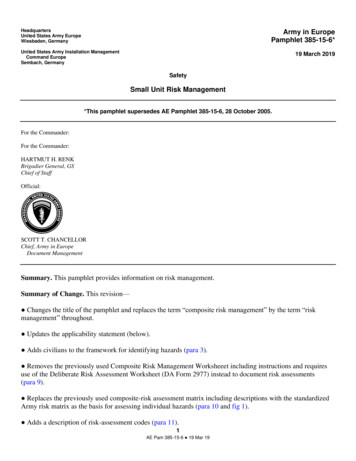
Transcription
HeadquartersUnited States Army EuropeWiesbaden, GermanyArmy in EuropePamphlet 385-15-6*United States Army Installation ManagementCommand EuropeSembach, Germany19 March 2019SafetySmall Unit Risk Management*This pamphlet supersedes AE Pamphlet 385-15-6, 28 October 2005.For the Commander:For the Commander:HARTMUT H. RENKBrigadier General, GSChief of StaffOfficial:SCOTT T. CHANCELLORChief, Army in EuropeDocument ManagementSummary. This pamphlet provides information on risk management.Summary of Change. This revision— Changes the title of the pamphlet and replaces the term “composite risk management” by the term “riskmanagement” throughout. Updates the applicability statement (below). Adds civilians to the framework for identifying hazards (para 3). Removes the previously used Composite Risk Management Worksheeet including instructions and requiresuse of the Deliberate Risk Assessment Worksheet (DA Form 2977) instead to document risk assessments(para 9). Replaces the previously used composite-risk assessment matrix including descriptions with the standardizedArmy risk matrix as the basis for assessing individual hazards (para 10 and fig 1). Adds a description of risk-assessment codes (para 11).1AE Pam 385-15-6 19 Mar 19
Updates information regarding the determination of risk-acceptance decision authority (para 12). Adds documentation requirements for operations that deviate from written safety standards (para 13). Provides a risk-acceptance matrix to help determine the risk-acceptance decision authority (fig 2) and amatrix showing civilian equivalency to military grades (fig 3). Makes administrative changes throughout.Applicability. This pamphlet applies to U.S. Army elements and regionally allocated forces stationed ortraining within the Army in Europe area of operations.Records Management. Records created as a result of processes prescribed by this pamphlet must be identified,maintained, and disposed of according to AR 25-400-2. Record titles and descriptions are available on theUnited States Army Records Information Management System website at https://www.arims.army.mil.Suggested Improvements. The proponent of this pamphlet is the Safety Division, Office of the Chief of Staff,HQ USAREUR (USAREUR Safety Division (mil 537-3092)). Users may send suggested improvements to thispamphlet by e-mail to the USAREUR Safety Division at stribution. This pamphlet is available only electronically and is posted in the Army in Europe Library &Publishing System at http://www.aepubs.eur.army.mil/.CONTENTS1. Risk-Management Process2. Risk-Management Terms3. Framework for Identifying Hazards–METT-TC4. Types of Accidents5. Cause Factors6. Sources of Cause Factors7. Most Likely Hazards and Their Controls8. Are You and Your Soldiers Ready to Perform Duties?9. Deliberate Risk Assessment Worksheet (DD Form 2977)10. Risk-Assessment Matrix for Individual Hazards11. Risk-Assessment Codes and Descriptions12. Determining the Risk-Acceptance Decision Authority13. Deviation Documentation and Risk Acceptance14. Risk Management Integrated Into Troop-Leading ProceduresFigures1. Standardized Army Risk Matrix2. Risk-Acceptance Authority for Safety Standards Deviation3. Military–Army Civilian Equivalent GradesAppendixesA. ReferencesGlossary2AE Pam 385-15-6 19 Mar 19
1. RISK-MANAGEMENT PROCESSRisk management is the process of identifying and controlling hazards to protect the Force. It is applicable toany mission and environment. The five steps of the risk-management process are as follows:a. Identify Hazards. Identify hazards to the Force. Consider all aspects of current and future situations, theenvironment, and known historical problem areas.b. Assess Hazards. Assess hazards to determine risks. Assess the effect of each hazard in terms of potentialloss and cost based on probability and severity.c. Develop Controls and Make Risk Decisions. Develop control measures that eliminate the hazard orreduce its risk. As control measures are developed, risks must be reevaluated until all risks are reduced to alevel where benefits outweigh the potential cost.d. Implement Controls. Put controls in place that eliminate hazards or reduce their risks.e. Supervise and Evaluate. Enforce standards and controls. Evaluate the effectiveness of controls andadjust and update them as necessary.2. RISK-MANAGEMENT TERMSControlsActions taken to eliminate hazards or reduce their risksExposureThe frequency and length of time subjected to a hazardHazardAny real or potential condition that can cause injury, illness, or death; damage to orloss of equipment or property; or mission degradationProbabilityThe likelihood that an event will occurResidual Risk The level of risk remaining after controls have been identified and selected forhazards that may result in loss of combat power. Controls are identified and selecteduntil the residual risk is at an acceptable level or until it cannot be practicablyreduced further.RiskThe chance of hazard or bad consequences, or exposure to a chance of injury orloss. The risk level is expressed in terms of hazard probability and severity.RiskAssessmentThe identification and assessment of hazards (first two steps of the risk-managementprocess)Risk Decision The decision to accept or not accept the risks associated with an action, made by thecommander, other leader, or individual responsible for performing the actionSeverityThe expected consequence of an event that could occur in terms of degree of injury,property damage, or other mission-impairing factors (for example, loss of combatpower, adverse publicity)3AE Pam 385-15-6 19 Mar 19
3. FRAMEWORK FOR IDENTIFYING HAZARDS—METT-TC (Mission, Enemy, Terrain, Troops,Time, Civilians)MISSION: Specified, implied, and subtasksENEMY: Size and capability (size, activity, location, unit, time, equipment (SALUTE))TERRAIN (AND WEATHER): Environmental conditionsTROOPS (AND EQUIPMENT): Troops: training, type, number, and physical condition Equipment: amount, type, design, and conditionTIME AVAILABLE: Time to plan, rehearse, and executeCIVILIANS: Situations involving civilians (including stability and support operations)4. TYPES OF ACCIDENTSGROUNDAVIATIONCombat SoldieringBrownoutMaintenanceHard landingMateriel handlingOvertorqueTracked vehicleTree strikeWeapons handlingWire strikeWheeled vehicle5. CAUSE FACTORSHuman Error (80 percent)Environment (15 percent) Birds, bugs, snakes, and other animals; poisonous plants Contaminants (carbon monoxide, chemicals, debris, foreign objects, fumes) Illumination (bright, dark) Precipitation (ice, rain, snow) Surface and space (confined, inclined, rough, slippery) Temperature and humidity (cold, hot) Wind and turbulence4AE Pam 385-15-6 19 Mar 19
Materiel and Equipment Failure (5 percent) Aircraft (cargo hook and sling, compressor, fuel control) Maintenance (hand tools, wheel split rims, winches and hoists) Tracked vehicle (hatches, tracks, weapon system) Weapon (machinegun, pistol, pyrotechnic simulator) Wheeled vehicle (brakes, electrical systems, tires)6. SOURCES OF CAUSE FACTORSINDIVIDUAL48 percentSoldier knows and is trained to the standard, but chooses not to follow the standard(lack of self-discipline). Alcohol and drugs Attitude Fatigue (self-induced) Haste OverconfidenceLEADER18 percentLeader does not enforce the standard. Lack of direct supervision Lack of higher command supervision Lack of unit command supervisionTRAINING18 percentSoldier is not trained to the standard (incorrect, insufficient, or no training on the task). Insufficient experience or on-the-job training Lack of school attendance Insufficient unit trainingSTANDARDS Standards and procedures are not clear or practical, or do not exist. Unclear tasks, conditions, and standards (common tasks, mission training plans)8 percent Insufficient or nonexistent operating proceduresSUPPORT8 percentEquipment is improperly designed or resources are not provided. Inadequate maintenance or facilities Insufficient number or type of personnel services5AE Pam 385-15-6 19 Mar 19
7. MOST LIKELY HAZARDS AND THEIR CONTROLSDismounted movement in conditions of limited visibility or adverse terrain Use night-vision devices. Wear eye protection. Run and jump only when tactically necessary. If you cannot see, STOP! Use marked lanes when available. Warn others of hazards encountered. Maintain three points of contact on steep or slippery slopes.Excessive speed Brief track commanders (TCs), drivers, and senior occupants on speed limits— In bivouac areas and battle positions. During closed and open nuclear, biological, and chemical (NBC) protection modes. During convoy “catch up.” When visibility is limited. Near road, terrain, and trail hazards. For different vehicle designs and cargo loads.Following too closely Set convoy-vehicle intervals based on the condition of drivers, visibility, road conditions, and the vehicles.Increase intervals when— Drivers are fatigued. Visibility is limited (dust, fog, night, rain, snow). The road is rough or slippery. Vehicles are heavily loaded or in poor condition.Hot- and cold-weather injuries Identify Soldiers who are not acclimated or have had previous hot- or cold-weather injuries and— Report these Soldiers to the chain of command. Assign appropriate duties. Watch closely for symptoms. Enforce work, rest, and hydration schedules. Adjust the workload when temperatures are extreme (more than 80 F, less than 32 F).Improper crew coordination Use positive communication (confirm that crewmembers have received and understand your communicationor signal). Announce decisions and actions. Perform all actions in the proper sequence and at the right time. Provide and request assistance when needed.Improper ground-guiding Use ground guides when— Operating in congested areas (assembly and battle positions, bivouac areas, maintenance areas). Operating with limited visibility. The vehicle intercom system is inoperative (tracked vehicles only).6AE Pam 385-15-6 19 Mar 19
Improper lifting and carrying of weapons and individual equipment Brief and enforce the following precautions: Use safe lifting, balancing, and carrying techniques. Schedule rest halts and rotate heavy loads during halts. Treat all weapons as if they were loaded. Keep blank and live ammunition separate. Keep weapons on safe until ready to fire. Do not use a weapon as a support or pull stick.Improper passing Pass other vehicles only at safe places and times considering road, visibility, and traffic conditions. Know the clearance space needed for both the vehicle and the trailer.Improper turning Yield the right-of-way. Avoid oversteering. Perform U-turns only in authorized areas and locations.Passengers or crew exposed during operation on rough terrain (tracked vehicles) Ensure that passengers and crew are positioned no higher than nametag defilade. Ensure that equipment and cargo are stowed and secured according to the load plan. Wear seatbelts when seated.Seating and placement of passengers (wheeled vehicles) Spot check vehicles to ensure that— No passengers are in the trailer or cargo area of vehicles carrying ammunition, explosives, or hazardousmaterial, or in the last vehicle of a convoy. Only one driver and passenger are in the cab of vehicles that have manual transmission. Seating provides for three points of contact on a fixed surface inside the vehicle and on sideboards.Unsafe road conditions (wheeled vehicles) Select and provide a briefing on routes that minimize unsafe conditions, including— Curves. Inclines. Narrow or congested passages. Slippery surfaces (icy, muddy, wet).Unsecure hatches and ramps Inspect hatches and ramps and repair those that are unsecure. Secure hatches and ramps with a locking pin or latch devices during operation.Unsecure or unstable load Ensure that loads are secured according to the load plan and applicable manuals. Spot-check vehicles with emphasis on ammunition, cargo center of gravity, and pyrotechnics.Vehicle deficiencies not identified or fixed due to improper preventive maintenance checks andservices (PMCS) Report deficiencies to the proper authority in a timely manner. Ensure proper PMCS by conducting maintenance spot-checks on vehicles before dispatch or operation.7AE Pam 385-15-6 19 Mar 19
Vehicle fire Give a briefing on and rehearse fire procedures according to appropriate operators manuals.Vehicle rollover Ensure that the TC or senior occupant gives a briefing on rollover procedures and that rollover drills areconducted.8. ARE YOU AND YOUR SOLDIERS READY TO PERFORM DUTIES?QUALIFICATIONYesNoYesNo Combat Lifesaver Leader and Noncommissioned Officer CertificationTRAINING Accident and unsafe-act reporting and correction procedures Avoiding poisonous plants Avoiding wild animals, insects, snakes, and so on Drivers training (tracked vehicles only) Crew coordination Rollover procedures (passengers and crew) Drivers training (wheeled and tracked vehicles) Adverse weather or terrain Convoy procedures (tactical and nontactical) Ground-guide procedures (for example, signal, distance) PMCS (before, during, and after) Safe speed for conditions Vehicle capabilities Loading and securing (vehicles and trailers) Equipment Personnel Materiel handling (lifting, carrying, balancing, footing, and so on) Night operations (collective, individual, and mission-essential task list (METL) tasks) Night-vision devices Capabilities Maintenance Wear while performing— Collective tasks Individual tasks METL tasks Weapons handling (safety procedures) Ammunition Clearing Duds8AE Pam 385-15-6 19 Mar 19
TRAINING (Continued)YesNoYesNoYesNoYesNoYesNo Fratricide prevention Laser Limited visibility and adverse weather PyrotechnicsEXPERIENCE Newly assigned personnel Proficient CurrentPHYSICAL AND DECISION-MAKING ABILITY Well rested and alert (for example, less than 15 hours of continuous duty and morethan 5 hours of sleep in the last 24 hours)EQUIPMENT (PERSONAL PROTECTIVE AND OPERATIONAL) Canvas and bows Insect repellant and stinger kits Night vision devices Personal protective equipment Hearing protection Goggles and scarf (for dust, mud, snow, rain, and so on) Kevlar and combat vehicle crewman helmet Seatbelts (when available) Tailgate and ramp safety (safety strap if applicable)CLOTHING Appropriate gear (seasonal) Inventory (accountability) NBC protective gear9. DELIBERATE RISK ASSESSMENT WORKSHEET (DD FORM 2977)A Deliberate Risk Assessment Worksheet (DD Form 2977) must be used to document risk assessments. Theform, including instructions, is available at rms/dd/dd2977.pdf.9AE Pam 385-15-6 19 Mar 19
10. RISK-ASSESSMENT MATRIX FOR INDIVIDUAL HAZARDSStandardized Army Risk MatrixProbability (expected frequency)Severity (expectedconsequence)Frequent:Continuous,regular, orinevitableoccurrencesLikely:Several ornumerousoccurrencesOccasional:Sporadic atastrophic:Death, unacceptable lossor damage, missionfailure, or unit readinesseliminatedIEHEHHHMCritical:Severe injury, illness,loss, or damage;significantly degradedunit readiness or missioncapabilityIIEHHHMLModerate:Minor injury, illness, loss,or damage; degradedunit readiness or missioncapabilityIIIHMMLLNegligible:Minimal injury, loss, ordamage; little or noimpact to unit readinessor mission capabilityIVMLLLLEH – extremely high riskH – high riskL – low riskM – medium riskFigure 1. Standardized Army Risk Matrix11. RISK-ASSESSMENT CODES AND DESCRIPTIONSSymbolEHHMLRisk-Assessment Code123410AE Pam 385-15-6 19 Mar 19DescriptionExtremely HighHighMediumLow
12. DETERMINING THE RISK-ACCEPTANCE DECISION AUTHORITY (Who Can Accept WhichLevel of Risk?)Once potential countermeasures and controls have been developed, risk decisions need to be made. Thisinvolves deciding which countermeasures to use and accepting residual risks.a. The decision to select countermeasures and controls can often be made at the lowest levels by theimmediate leader, designer, or process developer. However, when the hazard is not eliminated or controlled totolerable limits, Army leaders need to decide on the acceptability of the risk based on mission requirements.Accepting risk is a serious matter; therefore, the appropriate level of Army leadership must weigh the increaseddanger to the mission, personnel, equipment, public, property, and environment against the operationalrequirement that necessitated acceptance of a significant level of risk. As a decision-making tool, riskmanagement is effective only when the information is passed to the appropriate level of command for decision.b. The appropriate risk-acceptance authority is typically determined by three factors: the duration of the risk,the level of risk, and the ownership of the resources necessary to control, eliminate, or correct the hazard withinan appropriate timeframe. The exposure of unrelated personnel to risk and the resulting level of requiredcoordination may also affect the required level of risk acceptance (for example, the exposure of host-nationfacilities to risk from an Army operation).c. Army service component commanders are required to establish and publicize the approval authorities forrisk acceptance and decision-making for their commands or adopt, in writing, the standards in table 4-1 ofDA Pamphlet 385-30 (fig 2).d. The duration of the risk is the total length of time that the mission, personnel, equipment, property, orenvironment will be exposed to the hazard. When determining the required risk-acceptance level in figure 2, theduration of the risk will not be divided into shorter increments to lower the level of authority for accepting therisk. Consideration must be given to whether the mission is recurring or nonrecurring.(1) Recurring Missions. Recurring missions are operations that are cyclic in nature, are anticipated tooccur again in the near future, and involve the same hazards, control measures, and risks during eachoccurrence, such as night-training flights, rifle-range training, and so on. For recurring missions, the durationshould be based on the anticipated total amount of time to accomplish all recurring missions. If, for example,the mission will be conducted for 1 week every month for 3 years, the duration used would be 3 years, not 1week or 1 month.(2) Nonrecurring Missions. Nonrecurring missions are missions that are not anticipated to occur againin the near future. Normally, these types of operations occur during contingencies, wartime conditions, or otherunique situations.e. The level of authority accepting the potential consequences of a given hazard is determined by the level ofresidual risk associated with that hazard, mission, or event. The greater the risk and longer the duration, thehigher that decision must be elevated. In organizations led by Army civilian leaders, equivalent civilian gradesmay be substituted for military ranks (fig 3).11AE Pam 385-15-6 19 Mar 19
Figure 2. Risk-Acceptance Authority for Safety Standards Deviation(Table 4-1 of DA Pam 385-30)Figure 3. Military–Army Civilian Equivalent Grades(Table 4-2 of DA Pam 385-30)NOTE: Military grade abbreviations used in figures 1 and 2 are defined in the glossary.12AE Pam 385-15-6 19 Mar 19
f. Risk can be accepted only by the commander who has the resources or authority, or both, necessary tocontrol, eliminate, or correct the hazard within an appropriate timeframe. When unrelated personnel, facilities,or equipment are exposed to a hazard, the appropriate authority in the exposed organization will acknowledgethe hazard and accept the risk to their personnel, facilities, or equipment. On Army installations, the installationcommander is ultimately respo
Mar 19, 2019 · This pamphlet provides information on risk management. Summary of Change. This revision— Changes the title of the pamphlet and replaces the term “composite risk management” by the term “risk management” throughout. Updates the applicability statement (below). Adds civilians to the framework for identifying hazards (para 3).



